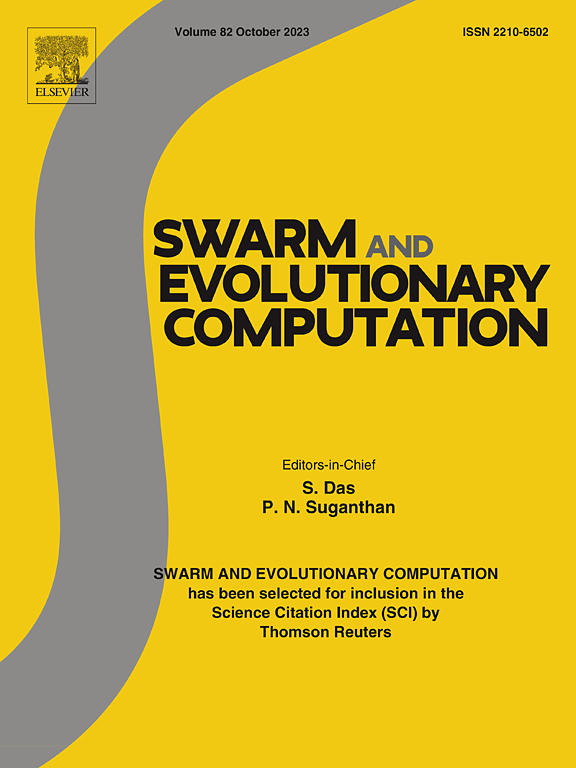利用元启发式优化算法模拟毛织物的声学行为
IF 8.5
1区 计算机科学
Q1 COMPUTER SCIENCE, ARTIFICIAL INTELLIGENCE
引用次数: 0
摘要
毛织物虽然广泛应用于家庭和汽车行业,但尽管具有结构优势,但尚未对其声学性能进行研究。本研究考察了它们的吸声性能,并使用元启发式优化算法对其进行建模。实验结果表明,垫层间距是最具影响力的结构变量,与直孔分数的减少和面密度的增加有关。声学建模采用Maa的微穿孔板、Garai-Pompoli的等效流体和Johnson-Champoux-Allard (JCA)微结构模型。利用粒子群优化(PSO)、动态多群粒子群优化(MPSO)、人工蜂群优化(ABCO)和鱼群搜索优化(FSSO)对微结构参数(扭曲度、形状因子、尺度因子和孔隙度校正因子)进行了估计。其中,JCA-PSO与实验吸声系数(SAC)数据吻合最好,引入有效孔隙度时,其均方根误差(RMSE)从0.053减小到0.045。虽然所有算法都给出了类似的SAC预测,但MPSO被证明是最快和最稳定的,而FSSO效率最低。总体而言,将元启发式算法与微观结构建模相结合,为纤维介质的参数估计提供了一种鲁棒且计算效率高的方法。研究结果强调,毛织物是一种轻质、高性能的隔音材料,在汽车和建筑噪音控制方面具有潜在的应用前景。本文章由计算机程序翻译,如有差异,请以英文原文为准。
Modelling the acoustic behaviour of tricot fabrics using metaheuristic optimization algorithms
Tricot fabrics, though widely used in household and automotive sectors, have not been investigated for their acoustic behaviour despite structural advantages. This study examines their sound absorption performance and models it using metaheuristic optimisation algorithms. Experimental results showed underlap pitch as the most influential structural variable, linked to reductions in straight pore fraction and increases in areal density. Acoustic modelling was performed with Maa’s micro-perforated panel, Garai-Pompoli’s equivalent fluid, and Johnson-Champoux-Allard (JCA) microstructural models. Microstructural parameters (tortuosity, shape factor, scale factor, and porosity correction factor) were estimated using particle swarm optimisation (PSO), dynamic multi-swarm PSO (MPSO), artificial bee colony optimisation (ABCO), and fish school search optimisation (FSSO). Among these, JCA-PSO achieved the best agreement with experimental sound absorption coefficient (SAC) data, reducing the root mean square error (RMSE) from 0.053 to 0.045 when effective porosity was introduced. While all algorithms gave comparable SAC predictions, MPSO proved the fastest and most stable, and FSSO the least efficient. Overall, the integration of metaheuristic algorithms with microstructural modelling offers a robust and computationally efficient approach for parameter estimation in fibrous media. The findings highlight tricot fabrics as lightweight, high-performance acoustic materials with potential for automotive and architectural noise-control applications.
求助全文
通过发布文献求助,成功后即可免费获取论文全文。
去求助
来源期刊

Swarm and Evolutionary Computation
COMPUTER SCIENCE, ARTIFICIAL INTELLIGENCEC-COMPUTER SCIENCE, THEORY & METHODS
CiteScore
16.00
自引率
12.00%
发文量
169
期刊介绍:
Swarm and Evolutionary Computation is a pioneering peer-reviewed journal focused on the latest research and advancements in nature-inspired intelligent computation using swarm and evolutionary algorithms. It covers theoretical, experimental, and practical aspects of these paradigms and their hybrids, promoting interdisciplinary research. The journal prioritizes the publication of high-quality, original articles that push the boundaries of evolutionary computation and swarm intelligence. Additionally, it welcomes survey papers on current topics and novel applications. Topics of interest include but are not limited to: Genetic Algorithms, and Genetic Programming, Evolution Strategies, and Evolutionary Programming, Differential Evolution, Artificial Immune Systems, Particle Swarms, Ant Colony, Bacterial Foraging, Artificial Bees, Fireflies Algorithm, Harmony Search, Artificial Life, Digital Organisms, Estimation of Distribution Algorithms, Stochastic Diffusion Search, Quantum Computing, Nano Computing, Membrane Computing, Human-centric Computing, Hybridization of Algorithms, Memetic Computing, Autonomic Computing, Self-organizing systems, Combinatorial, Discrete, Binary, Constrained, Multi-objective, Multi-modal, Dynamic, and Large-scale Optimization.
 求助内容:
求助内容: 应助结果提醒方式:
应助结果提醒方式:


